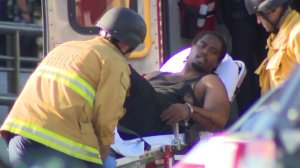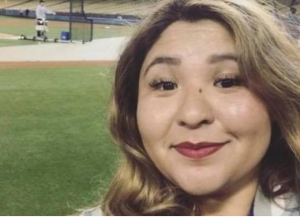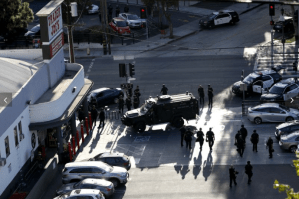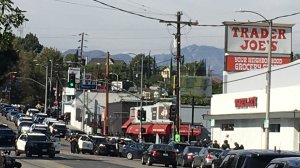Standing near the registers at Trader Joe’s, MaryLinda Moss threw herself to the ground when she heard the sound of gunshots.
She called her 14-year-old daughter, who was waiting inside their car in the parking lot. “I said ‘There’s a shooter, hide in the bottom of the car,’ and then I hung up.”
In just those same few moments, she heard what sounded like a car crash outside — followed by the sound of sirens that seemed to come just too soon after.
It would be another three hours before Moss left the store.
The 55-year-old artist and art consultant would come to play a crucial role in helping Gene Atkins, 28, negotiate with police as dozens were held hostage inside the Silver Lake grocery store on July 21.
In an interview with KTLA’s Frank Buckley, Moss described those first few moments of chaos and a gradual, measured set of negotiations that took place over multiple phone calls with police in the hours after. The following is her account of those events.
Before ending up in Silver Lake, Atkins allegedly shot his grandmother multiple times at their home in South L.A. earlier that day, then kidnapped his girlfriend as he escaped in his grandmother’s car. He led Los Angeles Police Department officers on a chase that would end in a crash and deadly shootout just outside the grocery store about 10 miles away.
He had gotten into an argument about his girlfriend’s staying over at the house, according to family members who spoke with KTLA.
Meanwhile, the police shootout outside the store killed Melyda Corado, a 27-year-old manager at the store. She died from a bullet shot by police, and since the killing, attorneys for her family say police acted out of department policy when they shot toward a crowded grocery store.
Atkins has been charged with murder in Corado’s death, along with several other criminal counts.
But Moss, of course, didn’t know any of that when she first saw Atkins enter the store, “bleeding profusely from a bullet wound in his arm,” she said. And she said she’s glad she didn’t.
As she continued to lie on the ground, surrounded by other people doing the same, the only thing she knew was a shooter appeared to be among them.
“There are people screaming, there are people running, there are people saying ‘get down,'” she said.
Standing at the end of the registers, Atkins asked one of the shoppers to pour water on his wound. The man told him he had a 9-year-old child in the car and asked to leave. Atkins agreed to let him go, but kept the man’s phone.
The immediate moments after are a bit of a blur, Moss said, but she remembers helping Atkins with his wound.
“I’m not sure exactly what happened — whether he asked me or whether I just stood up to help, I’m not sure — but I started looking around for something to wrap his wound in,” she said.
She was wearing a tank top with a “an over-shirt kind of dress” layered over it, which she decided to use. She removed the insulin pump under her shirt, placing it on the counter so she could take the dress off and use it to wrap around his arm.
When she spotted the gun resting in his right hand a moment later, she asked him to point it away, saying it made her “uncomfortable.” He agreed.

“There was a couple times that that happened and he would always point it away,” she said. “So … the whole time, he wasn’t threatening with the gun; he wasn’t aggressive towards us. But he had a gun.”
Some time later, a man named Mike suggested Atkins use his belt as a tourniquet to control the bleeding. Moss then wrapped the wound using his belt. She later agreed to massage Atkins’ hand when he asked her to.
“I sat down next to him and I massaged his hand and it seemed to help,” she said.
When Atkins spotted a closet filled with jackets, she offered to go grab one for him. As she went up to get the jackets, she walked past the register counters and saw people lying on the ground between them.
“There’s a woman lying behind the counter and as I walked by her, she didn’t move,” Moss said. “I was fearing the worst, and then I grabbed the jackets and then as I turned around, I saw that … she was in a pool of blood.”
“I just knew that we needed to get her help, and I locked eyes with one of the Trader Joe’s employees who was sitting with two other shoppers and I was like, we have to get her help,” she said.
Moss would later learn the woman on the ground was Corado.
But she didn’t want to do anything different than what she promised Atkins. So she walked back and told him about the woman lying in blood.
“I said, ‘There’s a woman who’s been shot, and he said, ‘That’s not my fault, that was the police,'” she said. “And I was like, ‘OK, but she’s gonna need help.'”
He told her, “‘You’re pushing’ or ‘you’re going too fast,'” she recalled.
He would repeat those phrases several times, later, as she helped him negotiate with police.
Moss placed the jackets on Atkins and could see he was shivering and in shock. Then, she suggested having Mike and a Trader Joe’s employee carry the woman out to help. Atkins eventually agreed.
After Mike helped carry Corado out, he came back into the store — something he would do again later, despite being able to stay safely outside.
“The thing about Mike, he has a huge heart,” Moss said.
Moss described trying to keep Atkins calm throughout the encounter, trying to rationalize with him when he got “ramped up.” She saw him become anxious several times in negotiations with police later and as he tried calling his grandmother’s home at one point.

Becoming annoyed when the person on the other line doesn’t recognize the phone number, Atkins asked if his grandmother is OK. The person on the other line said she was in the hospital, but he kept asking if she was all right.
“And then there’s some more screaming that goes on and he’s getting really agitated and I’m thinking ‘Let’s keep this at a minimum,'” Moss said of the call.
She asked Atkins if she could hold the phone, and then asked the other person to call back if they found out about his grandmother’s condition. Then she hung up.
As Atkins sat before her, he appeared weak and sounded increasingly hopeless.
“He’s saying, you know, ‘It’s all over. I shot at a cop. I’m in for life,'” she said. “And, I said, ‘There’s always hope.'”
He said he never meant to hurt anyone else — a phrase Moss said he repeated “12 to 20 times” throughout the day.
Then she placed her hand over his heart.
“I said ‘I know you have a good heart, and I know you don’t want to hurt anybody,'” Moss said. “He said, ‘You don’t know what I did earlier today,’ and I said, ‘It doesn’t matter.'”
For Moss, there’s good in seeing humanity in everyone, as she explained. But it was also important to tell Atkins that for the sake of everyone else.

“I was grounding him in his own humanity … but it was really making sure to remind him, for him to know, because that was important for the rest of us,” she said. “You know, if he was giving up, that wasn’t good.”
Two Trader Joe’s employees and Mike had helped her tend to Atkins, getting him on the phone with police and trying to keep him from turning violent.
When an LAPD sergeant called, Moss could see Atkins getting irritated again. She took the phone and told police to come back with something to offer in exchange for hostages.
“I was trying to keep things calm,” she said.
Later, there was another negotiator, who was a professional and appeared better at keeping Atkins calm and de-escalating the situation, according to Moss.
As calls came in from police, Moss said she would ask for permission to pick up the phone and then gradually just started doing it with every call. Early on, the police sergeant offered to allow Atkins to speak with his girlfriend, who was being treated for a gunshot graze wound.
Police didn’t put the girlfriend in touch, but they later compromised and provided a recording of Atkins’ girlfriend telling him to leave the store.
But a complicated and delicate series of negotiations came first.
One of those compromises was the placement of a sharpshooter, which Atkins spotted standing on a roof outside with the gun pointed in his direction. “He’s saying, ‘If you don’t get him off the roof, somebody’s gonna get hurt and it’s gonna be your fault, just like it was with the other woman,” Moss remembers him telling her.
So she started yelling for the shooter to get down.
“He’s starting to countdown. Five. Four. Three. And, I’m still yelling, I’m yelling at the guy,” she said.
The sharpshooter came down.
Another frightening moment transpired when Atkins realized there were other people in the store, as most were hiding on the ground and another 20 were hidden away in a separate room.
To calm Atkins, Moss asked a Trader Joe’s employee to count the people for him. He did, but then Atkins asked for the people to be brought closer to him. As the people were being seated before Atkins, Moss could see the gun resting in his lap.
She realized everyone was now within shooting range. She asked to have the people move but Atkins insisted he needed to be able to see them.
Still, she tried to make sure people weren’t sitting directly in front, and some spread out.
People had been hiding in aisles, bathrooms, behind counters and elsewhere in the store, many of them unaware of what the gunman was doing until they were brought in closer.
“All of these people were having their own experience,” Moss said. “They did not know. They knew so much less.”
In the bread aisle, for instance, cheery tunes blaring over the stereo and the sound of an alarm masked most of what was going on near the registers, according to Moss.
For the rest of the time, Moss worked to get Atkins to let people leave one by one. One was a 15-year-old boy. Another was a woman in her 20s, who froze when Atkins told her to stop but eventually managed to get out.
Later, toward the end, Atkins spotted a SWAT truck just outside. He panicked, saying police weren’t working with him. But eventually he just asked to have the truck back up a little bit.
He wanted to have himself handcuffed by Moss in order to surrender.
“I was like, ‘That’s brilliant, there’s our way out,'” she said.
Mike went outside to get handcuffs and insisted on coming back in, as he and Atkins had built trust.

At that time, it appeared to be just Moss and Atkins, Mike and the two Trader Joe’s employees helping them left in the store.
But Atkins kept saying he needed more time.
After some back and forth with police, the recording of his girlfriend arrived. She was under anesthesia and “groggy,” the police told them, but she could be heard saying something like “I’m OK, go outside” three times, Moss said.
As Moss continued to talk to Atkins about surrendering, she told him he could live a full life in prison.
“Having someone there who was giving up, who had a gun, was not safe for any of us,” she said.
In one of their exchanges, Atkins told her he wished they had met before.
“He said to me … I just needed somebody to talk to,” she said.
While Moss said she does hold Atkins responsible for Corado’s death and other consequences of that day, she felt she was able to work with him since things didn’t appear to be getting more violent.
“If he had been a shooter, who was intending on killing as many people as he could, if he had been threatening, if he had started threatening hostages — it would have been a completely different circumstance,” she said.
Eventually, she placed him in handcuffs after he finally decided to surrender to police.
She took his gun and placed it inside a Trader Joe’s bag. She, Mike and the two store employees then joined him in going out of the store.
“We all stood up together and we walked out together,” she said.
Police were not comfortable with all of them coming out together, and initially refused that demand.
“So they yanked us all apart” when they came outside, Moss said.
“Mike, who I think was unsettled by the experience, reacted – and they basically put him down on the ground,” she said. “It was alarming.”
Hundreds of police officers were outside. Helicopters were flying overhead, and news crews were on the block.
Moss hugged the two Trader Joe’s employees, one of whom she said was 19 and the other not much older, before finding her family in the crowd.
She managed to text her daughter at some point during the encounter. And when her husband had sent a text asking if the shooter knew where she was, she only said she was negotiating and couldn’t text anymore.
“He turned to my kids and said, ‘Of course she is,'” Moss said. “Because they had been seeing hostage after hostage after hostage being let go and where they were, they would see them turning the corner and every time, it was, ‘Is it her? Is it her?'”
“He was like, ‘She’s gonna be one of the last ones out of there,'” she said.
Moss defended the actions taken by police, saying she holds “no judgement” even though an LAPD officer’s bullet killed Corado. “There were split-second decisions that were made,” she said, and the officer involved is likely “devastated.”
Still, she believes improvement should be made in police training — particularly with de-escalation of such incidents — and more mental health services could be made available and fewer guns on the street.
And she’s amazed at how the young Trader Joe’s employees and so many others managed to keep their cool.
“They didn’t shut down, they were clearly afraid, and yet … they did what they needed to do,” Moss said. “One of the other things that strikes me is that everybody knew what to do, which is actually a little sad to me.”
“Obviously, in the circumstance, it was good,” she said. “But the fact that right now, where we are in history, everybody knows how to handle a situation with a person with a gun … it’s very sad.”












